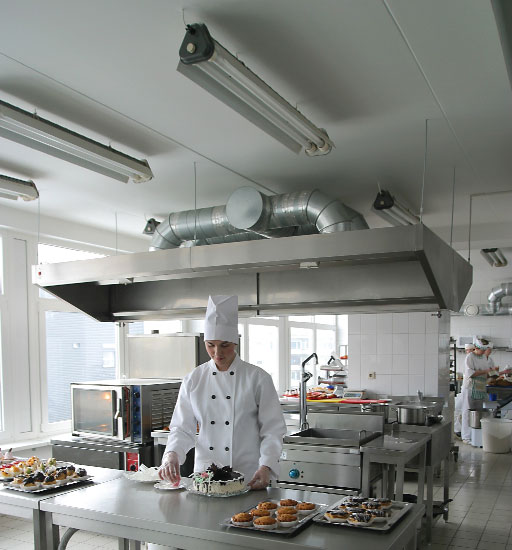With their typical bland colors and limited materials palette, one would assume that not much thought is given to selecting the workman-like coverings for walls and ceilings in restaurant kitchens— and it’s easy to see why it might appear that way: If no one is going to see it, does it really matter what goes on them? “Kitchen walls, even though they’re out of the public eye,” says Robert Doland of Jacobs Doland Foodservice Consultants, “still need to perform to a high functional standard. Durability, cleanability, and low-maintenance are the driving decision makers.”

Standard wall construction for restaurant kitchens should be water-resistant gypsum board (commonly called “green board” for the color) over a metal stud wall. Green board is the material of choice because of the moisture protection it offers in wet environments, like kitchen prep areas. For areas with even higher exposure to moisture, consider using cement board, which is heavier and more expensive than green board but offers better protection for wet areas. Both green board and cement board are excellent substrate for wall finishes such as tile or FRP (Fiberglass Reinforced Panels.) Albert Penna, of DNA Architects, says that, “Properly installed tile or FRP helps protect walls from the elements (grease, water, pests) throughout the operation of a commercial kitchen.” In addition, says Penna, “All walls need to meet health department requirements—a hard, light-colored, easily cleanable surface,” which both tile and FRP provide.
Wall construction is always going to be governed by jurisdictional codes regarding fire ratings—the duration of time which a wall can withstand a fire test. Walls that separate the kitchen from other spaces, like the dining room or access corridors and entryways, have to maintain a minimum fire rating so that in the event of a fire, the walls keep their integrity to prevent flames from spreading to adjoining areas. Required fire ratings are usually achieved by layering approved materials and providing insulation within the wall. For example, to obtain a 2-hour fire rating (which is typical for most walls separating kitchens from another space), the wall should have double layers of 5/8-inch- thick Type X Gypsum Board on both sides of the wall, along with 5½ inches of mineral wool insulation inside the wall. These thicker walls encroach upon the precious inches inside the kitchen, but are required for the safety of your employees and customers should an accidental fire occur. “Always check with your architects and consultants about what rating is required for kitchen walls,” adds Penna.
For closing in the space from above, similar rules apply to kitchen ceilings. Materials should be light-colored and easily cleanable, and “need to provide light to the workspace and sanitary protection from above,” notes Doland. One of the most cost-efficient and quick ways of doing so is by installing a drop ceiling of vinyl-coated ceiling tile in a heavy-duty grid. Typical dimensions for ceiling tiles are 2-feet square. The advantages of a drop ceiling, says Penna, is that “it’s easy to work around obstacles in the ceiling (columns, light fixtures, access points, utility connections, etc.) and it provides a cleanable surface and an even seam design.” Ceilings can also be constructed out of painted gypsum board, but Penna and Doland caution against this. “Access to above-ceiling elements is not simple and repairs, which may be needed from time to time, are difficult,” Penna contends. Doland adds that light fixtures become difficult to install without surface mounting them, and that creates more places for dirt and grease to collect. With a drop ceiling, damaged tiles can just be popped out and replaced, and light fixtures are easily integrated into the ceiling grid.
WALL FINISHES AT A GLANCE | |||
Material | Description | Advantages | Disadvantages |
Tile | Ceramic or glass tile, light-colored with epoxy grout | Seamless installation; easily cleanable; durable | Can be expensive |
FRP | Fiberglass Reinforced Panels—available in smooth or textured finishes in 48-in. panels | Cost effective; variety of color choices | Trim strips at joints between panels don’t provide complete smooth surface |
Stainless steel panels | Thin steel panels, up to 48-in. wide applied directly to wall system. Usually applied only to cooking lines and butchering rooms | Extremely durable and protective in high-heat, high-grease areas | Expensive; difficult to maintain |
Epoxy paint or scrub-able painted surface | Durable paint for use in low contact areas, like prep areas and storage rooms | Least costly surface; easily cleaned | Least durable |
Members help make our journalism possible. Become a Restaurant Business member today and unlock exclusive benefits, including unlimited access to all of our content. Sign up here.